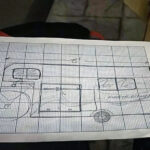The Harley Davidson “Marlboro Man” bike from the культовый 1991 film starring Mickey Rourke and Don Johnson has cemented its place in cinematic and motorcycle history. But beyond the movie magic, there’s a real story behind this iconic machine, particularly its distinctive exhaust pipes. RB Racing, a custom exhaust manufacturer, played a pivotal role in crafting the bike’s signature look and sound.
RB Racing wasn’t just any parts supplier; they were integral to the bike’s raw, stand-out aesthetic. As they put it themselves, these were the “same ones we ran from the cops with,” hinting at the rebellious spirit that permeates both the movie and the bike’s creation.
The story begins at Bartels Harley-Davidson in Culver City, CA, where Dave Fournier, tasked with bringing the movie bike to life, approached RB Racing. Bill Bartels, when asked about the exhaust, simply stated, “Just make it stand out because there will be a movie poster of the bike.” This directive set the stage for RB Racing to create something truly unique.
RB Racing fabricated several exhaust sets for Mickey Rourke’s FXR during the movie’s planning phase. The initial request was to create exhausts that would grab attention, ensuring the bike would be a focal point even on a movie poster. The result was a set of 1 1/2″ dual exhaust pipes, designed for a stroker motor. Interestingly, RB Racing notes that while these pipes provided exhilarating performance in first and second gear, they became restrictive in third gear, indicating they were somewhat undersized for optimal high-speed performance.
Despite being featured on a movie bike, the pipes were never painted black as some replicas depict. RB Racing left them in their bare metal finish, adding to the bike’s rugged and authentic character. It’s important to note that many “Marlboro Man bike” copies exist, but RB Racing emphasizes the originality of their work and the specifications of the bike they equipped.
Before its movie fame, RB Racing had already crafted exhausts for Mickey Rourke’s personal FXR. This connection predates the movie project, highlighting a long-standing relationship with Rourke and Bartels Harley-Davidson. The text humorously mentions the passage of time, referencing a “kid on the seat” who has since pursued a career far removed from “greasy motorcycles,” underscoring how long ago this iconic bike was conceived.
The late 1980s and early 1990s Hollywood scene, as described by RB Racing, was a vibrant mix of personalities, from movie producers to actors like Mickey Rourke, Gary Busey, James Caan, and Arnold Schwarzenegger. These figures, known for their love of motorcycles, were clients of RB Racing, seeking custom exhausts. The era of the “Hollywood ‘Johnny Rockets’ rumble crowd” is fondly remembered, a time when custom bikes and a certain rebellious attitude were intertwined with the film industry.
RB Racing experimented with different exhaust designs for the movie bike. One notable attempt was a set of two-inch severe cut megaphones intended to maximize visual impact, especially for promotional posters. The idea was to create “acres of chrome” that would be visually striking. While these megaphones were admired, the final decision leaned towards the 1 1/2″ drag pipes to achieve a specific “crackle” sound, deemed more fitting for the movie’s atmosphere. The bike pictured with the megaphones isn’t the actual movie bike, but serves to illustrate the alternative design RB Racing considered.
Bartels HD, recognizing the appeal of RB Racing’s designs, reportedly created copies of these exhausts. This highlights the influence RB Racing had on custom motorcycle aesthetics, with their designs even inspiring similar styles in later models, including V-Rods and Hooker exhausts.
The transformation of Mickey Rourke’s FXR for “Harley Davidson and the Marlboro Man” involved stripping away the white paint and chrome in favor of a raw, stripped-down look. This aesthetic was a departure from the flashy custom paint jobs that were popular at the time. Dave Fournier finalized the bike’s appearance, and RB Racing then fabricated the 1 1/2″ drag pipes that became so recognizable. The bike’s transformation reportedly cost around $40,000, a significant sum highlighting the dedication to achieving the desired look.
RB Racing recounts a memorable anecdote about testing the bike before it was delivered to the movie production. A third-gear test run near their shop led to a police chase. In a humorous turn of events, they managed to evade the police by utilizing their knowledge of the local area and some quick thinking, eventually resolving the situation by showing the police Mickey Rourke’s registration. This story adds to the legend of the bike and the slightly rebellious spirit associated with it.
After filming concluded, RB Racing created a set of 2″ drag pipes for the bike, suggesting ongoing modifications and refinements even after its cinematic appearance.
The team behind the “Marlboro Man bike” included key figures from Bartels Harley-Davidson: Gene Thomason and Dave Fournier. Gene Thomason, remembered as someone who “made things happen” and catered to Hollywood’s elite, passed away in December 2021. Dave Fournier, who spearheaded the bike’s build, later pursued his passion for locomotives in Arizona after retiring from motorcycle work. Their collaboration was crucial in bringing the iconic bike to fruition.
In conclusion, the Harley Davidson “Marlboro Man bike” is more than just a movie prop; it’s a symbol of a specific era in motorcycle culture and Hollywood. RB Racing’s involvement in crafting its distinctive exhaust pipes, along with the contributions of Bartels Harley-Davidson, solidified its status as a true original. The bike, sometimes referred to as “Black Death 3,” remains a sought-after icon, inspiring countless replicas and continuing to captivate motorcycle and movie enthusiasts alike. Its legacy is rooted in its raw aesthetic, powerful presence, and the stories of its creation by those who were deeply embedded in the custom bike scene.

